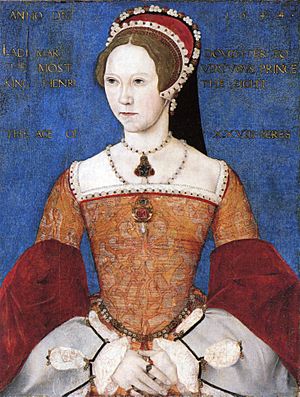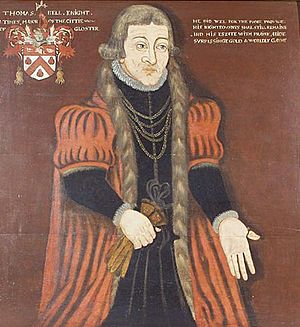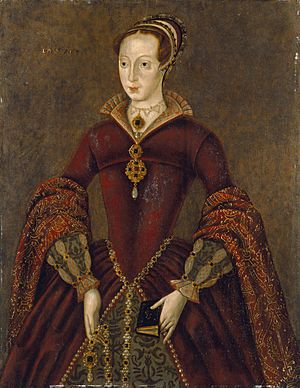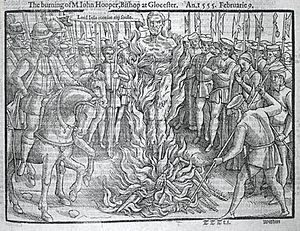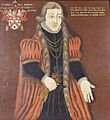Richard Morgan (Tudor judge) facts for kids
Sir Richard Morgan (died May 1556) was an important Welsh lawyer, judge, and politician during the Tudor period in England. He became well-known as a lawyer when King Henry VIII was in charge. Later, he served as the main legal advisor for the city of Gloucester. He was also elected as a Member of Parliament (MP) for Gloucester three times: in 1545, 1547, and March 1553.
Morgan was a strong supporter of the Catholic Church. He backed Queen Mary I, who made him the Chief Justice of the Common Pleas, a very high legal position. However, he was soon removed from this job and died in unclear circumstances, possibly due to a serious illness that affected his mind.
Contents
Early Life and Family Background
Richard Morgan was born in Monmouthshire, Wales. His father was Philip ap Morgan, and his mother was Maud Philpot. Richard was the second son in his family. His older brother, Dafydd, passed away before their parents, so Richard became the main heir. He also had a younger brother, John Philip Morgan, who later became a Member of Parliament too.
Richard's family was part of the lower gentry, which meant they owned land but were not super rich or powerful. Because of this, Richard chose to study law to improve his family's standing and his own future.
Changes in Wales During Morgan's Time
Richard Morgan's family history connected back to the Normans who conquered south-east Wales. For a long time, Welsh families used a naming system where people took their father's name, like "ap Morgan" (meaning "son of Morgan"). Richard was one of the first in his family to change this. He started using "Morgan" as a last name, like people did in England.
This change in names showed bigger changes happening in Wales. King Henry VIII wanted to bring all of Wales under stronger central control. New laws, called the Laws in Wales Acts 1535–1542, officially made Wales part of England. Wales was divided into counties, just like England. This opened up new opportunities for educated and ambitious men like Richard Morgan to get ahead in politics and law.
Richard Morgan began his legal training at Lincoln's Inn in London on July 31, 1524. Even though he had a small reputation for being a bit wild, he quickly showed he was a talented lawyer. He became a qualified lawyer in 1528.
Legal and Judicial Career
After finishing his training, Morgan started working as a private lawyer in London. By the late 1530s, he was working for important people, including Arthur Plantagenet, 1st Viscount Lisle, who was a high-ranking official in Calais. When Lisle was later arrested, his many letters were taken, which helped historians learn about his dealings with Morgan. Richard Morgan was good at balancing his private law work, his duties at Lincoln's Inn, and his political activities in Monmouthshire.
He held many important roles at Lincoln's Inn, helping manage the legal school. He was an auditor several times and gave lectures to other lawyers. His lectures were on complex legal topics, showing his deep understanding of the law.
Around 1543, Morgan became the Custos rotulorum for Monmouthshire. This meant he was in charge of keeping the county's official records and was its most senior civil officer. He held this important position for the rest of his life.
In June 1546, King Henry VIII chose him to become a Serjeant-at-law, a very senior type of lawyer. He was officially appointed in February 1547, after Henry's death. By this time, he was also the main legal advisor, or Recorder, for the city of Gloucester. He represented Gloucester in Parliament between 1545 and 1553. He also worked for the Duchy of Lancaster, which owned a lot of land in Monmouthshire.
However, because Richard Morgan was a Roman Catholic, his career faced challenges when King Edward VI, a Protestant, came to power. On March 24, 1551, Morgan was sent to Fleet Prison because he attended a Catholic Mass at the chapel of Princess Mary. He apologized to the Privy Council (the king's advisors) and was released on May 4 with a warning. Despite this, he remained active in Parliament during Edward's reign, and his legal skills were still valued for important investigations and writing laws.
Loyalty to Queen Mary I
After King Edward VI died, Richard Morgan quickly joined Mary and her supporters at Kenninghall Castle. They successfully resisted the plan to make Lady Jane Grey queen instead of Mary. Mary rewarded Morgan for his loyalty. On August 16, 1553, she made him a Privy Councillor. On August 23, he became the Chief Justice of the Common Pleas, a very high judicial role. Finally, on October 2, he was knighted, becoming "Sir Richard Morgan." He also took part in the legal proceedings against Lady Jane Grey in November.
Sadly, in 1555, Sir Richard Morgan became mentally unwell and was removed from his job in October of that year. Some historical accounts, like those by John Foxe and Raphael Holinshed, claimed his illness was because he felt guilty about Lady Jane Grey's fate.
Political Career
Serving in Parliament (1545-1553)
Richard Morgan was elected to Parliament several times. In 1545, he was chosen by two areas: Gloucester and Monmouth Boroughs. Gloucester was a larger and more important area, and it was common for the city's legal advisor (Recorder) to be one of its MPs. Morgan likely sat for Gloucester in 1545, and he definitely did so in the next two parliaments.
Parliament of 1547
Morgan was re-elected to Parliament in 1547, during the start of Edward VI's reign. He became very active in this Parliament, using his legal skills to review and rewrite proposed laws. He helped with important bills, like one about how cities and towns paid their fees to the Crown.
He also became known for handling cases about the rights and special rules of Parliament itself. For example, he dealt with a complaint from Sir Robert Brandling, an MP who was attacked on his way to Parliament. Morgan made sure the attackers were brought before Parliament. He also helped investigate a case where another MP, William Ward, tried to use his parliamentary rights incorrectly. Morgan was part of a group that looked into this.
Morgan was also involved in rewriting the Treason Act 1551. This law made it illegal to say that the king was a "heretic" or "usurper."
Parliament of March 1553
In the last months of King Edward VI's reign, Morgan and another Catholic lawyer, Robert Broke, were asked by Parliament to investigate a problem with the election in Maidstone. The town had recently been given the right to govern itself, but it wasn't clear if it could elect MPs. This was a tricky time because there was a struggle over who would become the next ruler after Edward. The investigation's result is not fully known, but Maidstone's right to have MPs was not officially confirmed until 1558, after Queen Elizabeth I came to power.
This was Richard Morgan's last time serving in the House of Commons. When Queen Mary made him Chief Justice, he became ineligible for the House of Commons. Instead, he was called to serve in the House of Lords in 1553 and 1554.
Religious Beliefs
Richard Morgan's time in Fleet Prison showed he was a very strong Catholic. He was part of a group around Princess Mary who were deeply committed to the Catholic faith, even when it was dangerous. However, he continued to represent Gloucester, which was becoming a Protestant area, without much trouble. His skills as a lawyer were so valuable that different rulers could use him, which explains why his imprisonment was short.
His Catholic faith was very important to him. In his first will, written in 1552, he asked for a Catholic burial and for Catholic religious services, even though a new law at the time made such practices illegal.
His commitment to the Catholic faith was so strong that he personally attended the burning of John Hooper, a Protestant bishop, in Gloucester on February 9, 1555. This was not a required duty for his job. According to John Foxe, Morgan had been very harsh towards Hooper earlier. Foxe wrote that Morgan "began to rail at Master Hooper, a long time, with many opprobrious and foul words."
Death
The exact details of Richard Morgan's death are not fully clear. Historians from the time of Queen Elizabeth I believed he was punished for his strong opposition to the Protestant faith, especially for his role in condemning Lady Jane Grey. John Foxe wrote that Judge Morgan, after sentencing Lady Jane, "fell mad, and in his raving cried out continually to have the Lady Jane taken away from him, and so ended his life."
This story was repeated by others and became the common explanation for his sudden removal from power. However, Morgan was removed from his job in October 1555, almost two years after Lady Jane Grey's trial. There is no real proof that he ever changed his strong Catholic beliefs. His second will still asked for a Catholic burial. It is more likely that Morgan was suspended because of a serious illness that affected his ability to work as a judge. The idea that he went mad from guilt is probably not true.
It is known that Morgan and his wife were held by his younger brother, John Philip, around this time. The Privy Council ordered John Philip to release them, but it's not clear if he did. John Philip's own will suggests there were disagreements about property between the brothers.
Richard Morgan most likely died in late May 1556. He was buried on June 2 at St Magnus-the-Martyr, his local church in London. A detailed diary by a London merchant, Henry Machyn, described his funeral as a grand event, with a herald, banners, and many people attending.
In his last will, Morgan made sure his younger sons, John and Polydore, would share a lease of land. His oldest son and heir, Thomas, received other land leases, including part of the family home. His wife could use their London house, and his books were divided among his sons. He also left a special gold ring for his brother John Philip Morgan's wife, Anne, thanking her for her kindness during an earlier illness he had.
Family
Richard Morgan married Mary Bailey. She was the daughter of Sir Robert Bailey from Monmouthshire. Mary survived Richard and later married William Brayne.
Richard and Mary had at least seven children. Three of their sons lived to inherit property from Richard:
- Thomas Morgan, who was the main heir. He married Mary Pryce.
- John Morgan, who married Mary Worrall.
- Polydore Morgan
- Gilbert Morgan, who likely died before his parents.
- Elsbeth "Besse" Morgan, who married a man named Higgs.
- Anne Morgan, who married Thomas Quayne.
- Mary Morgan
Images for kids



